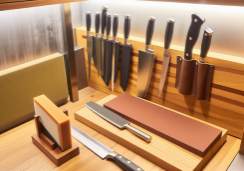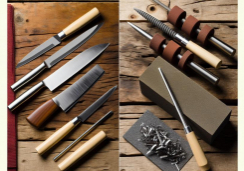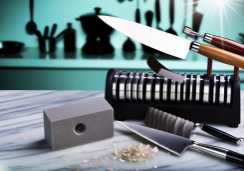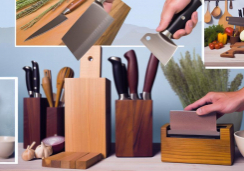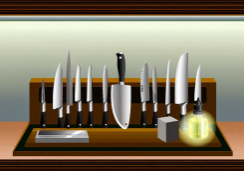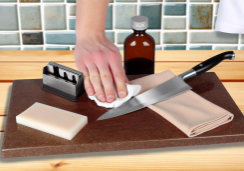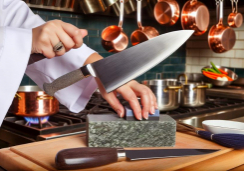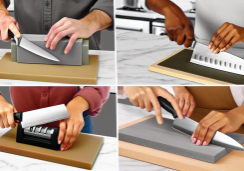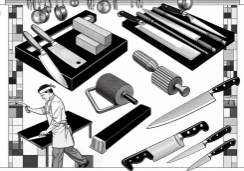What Makes Kitchen Knives Last Longer?
You've probably experienced the frustration of a once-sharp knife that now mangles tomatoes more than slices them. It's not just about the annoyance; it's also about the safety and efficiency that comes with using well-maintained kitchen tools.
The longevity of your knives hinges on several crucial practices, from the way you clean them to where you stash them after use. You may be familiar with the basics—like not putting knives in the dishwasher—but there's more to it than avoiding harsh detergents.
It's essential to understand the nuances of knife care, including how often you should sharpen the blades and the types of cutting boards that won't dull them prematurely. By reevaluating how you handle your knives, you'll not only extend their lifespan but also elevate your culinary skills.
Now, let's explore these pivotal factors one by one, ensuring that your knives outlast even your most ambitious cooking projects.
Proper Cleaning Techniques
To ensure your kitchen knives maintain their edge and resist corrosion, it's essential to clean them correctly immediately after use. Handwash each knife with warm water and a mild dish soap. Use a soft sponge or cloth to gently wipe the blade, being careful not to run fingers along the edge to prevent cuts.
It's crucial to avoid the dishwasher; the harsh detergents, high temperatures, and jostling can dull the blade and damage the handle.
After washing, rinse the knife thoroughly with clean water to remove any soap residue, which can be corrosive. Then, dry the knife immediately with a soft towel to prevent water spots and rust. Don't let it air dry, as prolonged exposure to moisture can lead to corrosion, especially for high-carbon steel blades.
Store your knife in a knife block, on a magnetic strip, or in a sheath to protect its edge. Never toss it into a drawer where it can get banged around, causing nicks or dulling. Regular honing is also recommended to keep the edge aligned, but remember that honing isn't a substitute for sharpening, which you'll need to do periodically to restore a sharp edge.
Correct Storage Solutions
Having discussed the proper cleaning of kitchen knives, we'll now explore the importance of storing them correctly to further protect their longevity and sharpness.
You must avoid tossing knives into a drawer where they can jostle against other utensils, which dulls their edges and increases the risk of accidents. Instead, invest in a knife block or magnetic strip. A knife block keeps blades separated and secure, but ensure it's dry to prevent corrosion. Magnetic strips display knives on the wall, making them easily accessible while saving counter space.
For those with limited space, consider a knife guard or a roll-up knife bag. Knife guards are plastic or felt-lined sheaths that shield the blade. They're ideal for individual knives and maintain sharpness when storing in a drawer. Roll-up bags, often used by professional chefs, provide a portable option that protects an entire set.
Lastly, avoid hanging knives near the stove or sink where heat and humidity can promote rust. Opt for a cool, dry place instead.
Regular Sharpening Routines
Maintaining your kitchen knives requires a regular sharpening routine to ensure they cut with precision and ease. A dull blade can be frustrating and dangerous, as it requires more force to cut, increasing the risk of slipping and injury.
To keep your knives in top condition, consider this four-step sharpening routine:
- Inspect Your Knives: Before sharpening, examine each knife for damage or wear. Look for nicks, uneven edges, or dullness that can impede performance.
- Choose the Right Tools: Use a whetstone or honing rod appropriate for your knife's material. For most kitchen knives, a medium grit stone is suitable for regular upkeep.
- Use Proper Technique: Hold the knife at the correct angle – typically between 15 to 20 degrees – and draw the blade across the stone with even, controlled strokes. Ensure you're sharpening the entire length of the blade, from heel to tip.
- Test and Repeat: After sharpening, test the knife on a piece of paper or produce. If it slices cleanly without resistance, you've achieved a sharp edge. If not, repeat the process, paying extra attention to any problem areas.
Appropriate Cutting Surfaces
Selecting the right cutting surface is as crucial as the knife you wield, because inappropriate boards can dull your freshly sharpened blades and shorten their lifespan. You'll want to avoid hard surfaces like glass, marble, or metal, as they can quickly blunt your knives. Instead, opt for cutting boards made of softer materials that provide a balance between firmness and give.
Wooden cutting boards are often recommended, as they're kind to your knives and have natural antibacterial properties. Look for ones made from hardwoods like maple, walnut, or cherry. These woods are dense enough to withstand cuts but won't dull your blades as quickly as harder materials. Bamboo is another excellent choice, known for its sustainability and durability.
Alternatively, consider composite boards, which are made from a combination of wood fibers and resins. These offer a similar feel to wood but are often more dishwasher-friendly, making cleanup a breeze.
Lastly, don't overlook plastic cutting boards. They're affordable and easy to sanitize. However, ensure they're not too hard, as cheap plastics can be as damaging as glass. Whichever material you choose, remember to regularly clean and maintain your cutting boards to prevent cross-contamination and further ensure the longevity of your kitchen knives.
Handling and Usage Tips
To ensure your kitchen knives remain sharp and effective, it's crucial to master the proper handling and usage techniques. Here's how to keep your blades in top condition:
- Use the Right Knife for the Task: Avoid using your chef's knife to crack open nuts or your paring knife to slice through frozen meat. Selecting the appropriate knife not only provides better results but also prevents unnecessary wear and tear.
- Employ the 'Pinch Grip': Hold the knife by pinching the base of the blade between your thumb and forefinger, while wrapping your other fingers around the handle. This grip offers superior control, reducing the risk of slippage and uneven pressure that can dull the blade.
- Cut with Intention: When chopping, use a fluid rocking motion instead of forceful hacking. This technique maintains the edge and minimizes damage to the cutting board. For slicing, draw the knife towards you, letting the blade do the work.
- Never Scrape with the Blade: After chopping, resist the urge to scoop ingredients with the knife's blade. Use the spine or a bench scraper instead to avoid blunting the edge.
– What qualities should I look for in a kitchen knife set to ensure longevity?
When searching for the best kitchen knife set, prioritize durable materials like high-carbon stainless steel. Look for knives with full tang construction for longevity and sturdy handles for a comfortable grip. Also, consider a set with a storage block to protect the blades and keep them organized.
Conclusion
In conclusion, you'll ensure your kitchen knives' longevity by adopting meticulous care habits. Regularly clean them by hand, store them in a secure spot, and sharpen them with precision.
Always use the right cutting boards to prevent dulling the blades. Handle them correctly, using them only as intended.
Stick to these practices, and your knives won't just last longer—they'll also perform better, making every slice and dice in your culinary endeavors a breeze.

